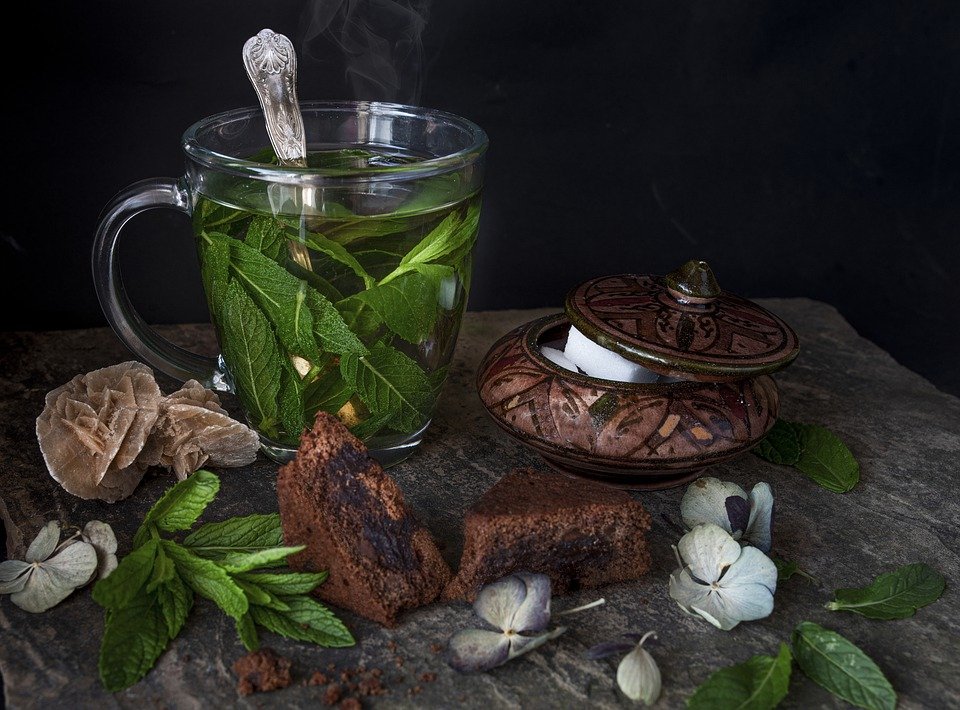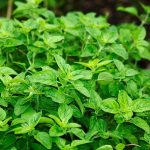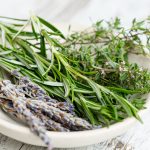There is no denying it: Herbal tea is the best. Nothing in the world is quite like sitting down with a cup of herbal tea. Unless it is a tall glass of iced herbal tea.
No one will talk you into ever going to a store and buying tea again, once you know the best herbs to grow for tea, how to grow them, dry them and prepare them to make your own fresh herbal tea.
When growing herbs for tea, you will have the satisfaction of having done it all yourself, from beginning to end. You will know for a fact that if you want your tea to be organic, it definitely is organic, with no recalls or uh-oh’s.
You will have the money in your wallet that would otherwise have gone to something that sat on a store shelf for months. You will have the convenience of walking out your back door and grabbing the makings for tea, rather than having to get ready, then go to the store. And, as said before, you will have flavor!
Interested? Of course!
How To Grow Your Own Tea Herbs
Herbs are one of the easiest plants in the world to grow. In fact, some tea herbs need to be grown in a restricted area, like a raised brick bed, or a pot, just because they are liable to spread too much. We call these kinds of herbs “excitable”, because they simply love life. Also because it’s a lot shorter than “liable to spread too much”.
Are You Starting Your Tea Herbs In A Cold Climate?
If there is still frost outside you will need to start your herbal tea garden indoors. You can do this from seeds or seedlings.
If you are starting your herb plants from seed, and doing so during a cold time of year, this is what you will need and the steps required:
- Starter pots-about 2″ diameter
- Potting soil
- Grow light
- Seeds
Put potting soil in the starter pots.
Add seeds. The number of seeds will vary, so please read the seed packet. Usually about 5-7 seeds per pot.
Push seeds down to twice their size. Since herb seeds are tiny, that means press them down as if pressing a button on your favorite remote. Water lightly.
Turn the grow light on for 4 hours a day UNLESS you get enough sunlight through a window to give your seedlings light for 4 hours a day. Then the grow light won’t be necessary.
How to grow your herbal tea garden outside in pots
Get a plant pot, put planting soil in it, put it outside in a sunny spot, after the last frost.
Sprinkle herb seeds around in the soil, press them down and water them.
After the seeds sprout, give one or two seedlings their own spot. Usually, a 6″ pot will do.
But, again, it varies with the herb.

What Is The Easiest Way to Start a herbal tea plant?
Buy a seedling! Yes, it’s cheating and costs a little more. But it’s faster.
Transfer each seedling to its own pot with a mix of potting soil and compost.
Water the soil so it is moist to touch.
Best herbs to grow for tea
You know how to grow your own tea herbs. Now, which herbs do you wish to grow? Do you have a favorite herbal infusion or blend you usually buy?
Many of the herbs you are already growing in your herb garden may be suitable for your herbal tea blends. Chamomile, a medicinal herb, is also a great tea herb.
Here are some popular tea herbs you may wish to grow in your herbal tea garden.
Chocolate mint
This is our favorite of all time. Remember those mint candies covered in chocolate? Or the yummy cookies sold every year? This smells and tastes just like those. It is ‘excitable’, but behaves pretty well if kept in its own container. Mint dies back in Winter and then grows back every Spring.

Mint
Another excitable plant and a culinary herb. Mint can boost the immune system and relieve aches and pains. It also protects the other herbs in your herbal tea garden because it is a bug repellent. Mint tea tastes like fresh mist, with hints of vanilla and fruit. It is cooling in summer and mixes with other flavors quite well. Try blending with Lavender.
Lemon Balm
A relative of mint. Lemon balm tastes like lemon and mint. It can boost mood and help with relaxing. Because it’s related to mint, it is excitable and needs its own pot.
Lavender
Helps with sleep & reduces inflammation. Lavender, a medicinal herb, tastes like mint and rose with a touch of rosemary. Try blending with rose and chamomile.

Rose Hips
Not the first thing one might think of when herbal tea is mentioned. However, rosehip tea tastes like apples and plums and is rich in antioxidants. Try infusing rose hips with lemon.
Simple Method To Turn Your Herbs Into Delicious Tea
Firstly start by washing your herbs to ensure you don’t get any dirt in your tasty tea. Select about a quarter of a cup worth of fresh leaves. Use more or less based on your taste. For ice tea double the amount used.
Heat your water to boiling point and tip over your herb leaves. This can be in the bottom of a teapot or strainer. Leave to steep for 5 – 10 minutes depending on your liking. Rosehips only needs half the time.
How to prepare your herbs for tea
As with most herbal preparations the basic steps are the same: cut, dry and store.
Use fresh herbs as they offer the most flavor. If you don’t plan on using them within a few hours, consider storing them in the refrigerator or placing them in a cool, dry location.
A few tips:
– Make sure your herbs and equipment are clean and sanitary. Wash your hands before starting to help prevent the spread of bacteria or mold which can ruin the flavor of the tea.
– It’s best to use freshly-cut herbs, especially if you’re making an herbal blend for boiling water. Unfortunately, fresh herbs are at their peak of flavor only for a few hours after they’re cut. If you buy them in bunches or plan to keep them on hand for more than one day, the best way how to dry herbs for tea is to place the bunch in a glass jar with an airtight lid and store them in the refrigerator.
– Tie the herbs with jute twine or thin cotton string into small bundles, leaving about 2 inches of stem on each piece to help them dry evenly. Tie tightly so they don’t come loose during the drying process – but not so tightly that you bruise the leaves or stems.

How to dry herbs for tea
To dry herbs for tea, clip or snip the herbs in small bunches and place them on a tray in a well-ventilated space. If you’re drying only one herb, keep it in a smaller bunch since there’s less surface area to expose to air.
In general, dried herbs will need about 1 inch of space between each other. An ideal situation is when there is lots of airflow from an overhead fan or cross breezes from a window open at both ends of a room with the pan holding the bunched herbs sitting nearer to the cool draft blowing through it. It’s also best if there aren’t any objects that might obstruct airflow (like table lamps or other heat sources like the stove) in the area where you’re working.
How long do I need to dry the herbs for my tea?
The drying time will depend on how much moisture is still in each herb, how much surface area it has for exposure to air, and how dry your climate is. It can range from a few days to 2 weeks.
Can I dry herbs in the oven or a microwave?
Yes, if you prefer using a microwave or conventional oven, tie the bundles of fresh or dried leaves in a loose bunch and cut off the stems. You can also remove the leaves from their branches.
Place a large sheet of parchment paper on a baking tray. Dump the leaves on top of it and use your fingers to spread them out as evenly as possible.
How to dry herbs for tea in a conventional oven
Bake the leaves at 250 degrees F (120 C) until they’re dried out, or until their color is relatively uniform and bright – usually after about 1 hour of baking time.
Use a cookie sheet or cake rack placed on top of a baking sheet in case there’s any liquid that drips off; this will keep your oven clean.
How to dry herbs for tea in a microwave
Cook the leaves on high heat for 1 minute, then turn them over and cook again on high heat for another minute. How many times you repeat this process depends on your oven’s wattage; check your microwave’s instruction manual for details.
How to store dried herbs for tea
Once your herbs are dry, they will crumble easily between your fingertips and be crisp or break into coarse pieces when you bend them – but not powdery. Store dried herbs in a sealed glass jar away from sunlight and use them within a year for best results.
How to make sun tea
Herbs added to cold water steep like tea, releasing their flavor and important nutrients into the liquid. The best time-honored way is to make sun tea, which harks back to colonial times when the world was a much larger place. Make water hot by heating it in a pan on the stove or in an electric kettle until bubbles begin to rise from the bottom of the pot where steam is trapped.
– Put a covered jar of herbs, water and sugar into the sunniest spot in your backyard or on your patio. Place it somewhere where it won’t be disturbed by curious children or pets who might knock it over. Some people leave their jars up high by hanging them from tree branches or posts. Others place them very low to the ground by putting them on a table or bench. The idea is for the herbs, water and sugar to be in direct sunlight with lots of airflow around them.
– Leave the jar outside in direct sunlight for at least 8 hours or overnight, but keep an eye out that it doesn’t sit too long in one spot – the same spot – and that the sun doesn’t start to bake it. Bring it inside as soon as you see condensation begin to form on the jar (you can also check by placing a finger over its opening and feeling how cool or warm the air is).
– If you plan to make your herbal blend an ingredient in something else, like If you want it as-is – perhaps you’ll mix it with lemonade or honey, for instance – it’s best to strain the finished mixture through cheesecloth or a fine sieve.
– If you’d rather use your homemade herb concoction as an ice pack for picnic hampers or car coolers, leave out the sugar.
I hope you enjoy making some delicious homegrown herbal tea with your own organic herbs. So kick back with your herbal infusion and check out our other growing guides.





Pingback:The ultimate herb gardening for beginners guide - Herb Growing Guide